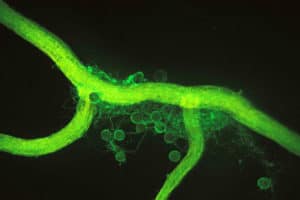Beneficial root fungi help plants absorb nutrients more efficiently
Sunlight and water are the most obvious, but certainly not the only, factors in plant health. Beneath the soil surface in the tiny space surrounding the plant’s roots, a vital interaction is taking place between the root cells and specialized beneficial fungi called mycorrhiza.
There are many types of mycorrhizal fungi, and more than 80% of land plants have symbiotic, or mutually beneficial, associations with them. Most plants depend upon this association for efficient nutrient uptake, and learning how to maximize and support the growth of mycorrhiza can be of great benefit to agricultural, ornamental and natural ecosystems.
 The world mycorrhiza comes from the Greek words for fungus and root. Mycorrhiza inhabit the rhizosphere, the zone of soil immediately surrounding the roots. There are several categories of mycorrhizal fungi; the one usually associated with agricultural and horticultural crops are arbuscular mycorrhiza (AM). This type grows into the roots themselves, developing tree-like branched structures called arbuscules where nutrients are exchanged. The hyphae, or branchlike structures of the mycorrhiza actually increases the reach of the roots, extending further out into the soil and absorbing and bringing back nutrients. In return, the mycorrhiza receive carbohydrates from the plant that it cannot produce on its own.
The world mycorrhiza comes from the Greek words for fungus and root. Mycorrhiza inhabit the rhizosphere, the zone of soil immediately surrounding the roots. There are several categories of mycorrhizal fungi; the one usually associated with agricultural and horticultural crops are arbuscular mycorrhiza (AM). This type grows into the roots themselves, developing tree-like branched structures called arbuscules where nutrients are exchanged. The hyphae, or branchlike structures of the mycorrhiza actually increases the reach of the roots, extending further out into the soil and absorbing and bringing back nutrients. In return, the mycorrhiza receive carbohydrates from the plant that it cannot produce on its own.
This extended “root system” greatly increases a plant’s ability to withstand stress, enabling it to survive even where nutrient levels would normally not be sufficient. There is even some evidence that mycorrhiza can help the host plant weather drought stress by increasing the root system’s reach in the search for water.
A number of nutrients are absorbed and transferred to plants by mycorrhiza. In particular, mycorrhiza aid plants with the uptake of phosphorous and nitrogen. Studies show that AM fungi have active phosphate transporters that absorb phosphorous from the soil and release it slowly to the plant. The plant also has phosphorous transporters specific to the mycorrhiza that receive the phosphorous and move it throughout the plant. Genes involved in nitrogen transport in AM fungi have been identified as well. Mycorrhiza are also helpful in the binding and transport of trace elements such as manganese and iron.
Mycorrhizal fungi benefit plant health in another important way — by stabilizing and improving soil structure. The fungi produce a sticky substance called glomalin that sloughs off and binds to soil and organic material, creating aggregates. This is beneficial in a number of ways — it increases moisture-holding capacity and aeration of the soil as well as erosion.
Keeping the population levels up of mycorrhizal fungi in the soil can be a benefit to plant health. Alpha-keto acids are soil amendments that have an important role in the metabolism and therefore the growth of mycorrhiza. Fertilizers such as KeyPlex 350 containing alpha-keto acids have the extra benefit of not only providing the nutrients directly, but also the support for the beneficial fungi that aid in nutrient absorption.
Planting cover crops, especially legumes, also help maintain healthy mycorrhiza populations.
